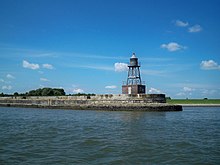Flak battery Tirpitzschleuse
The heavy flak battery Tierpitzschleuse was a bunkered position of the naval flak in Wilhelmshaven during World War II .
Location and structure
The battery was at the north end of the former 3rd entrance. It consisted of four gun beds which were arranged around a central control station and were connected to one another via a tunnel system. For self-protection, the battery had a 3.7 cm anti-aircraft gun on the north pier and a 2 cm anti-aircraft gun in a double carriage on the south pier.
Organizational integration
The German Bight Coast Commander was responsible for the coastal defense . The battery belonged as part of the II. Marine Flakbrigade to the Wilhelmshaven section. The flak battery belonged to the Marine Flak division 232, whose Flakuntergruppenkommando Hafen was in the Westwerft.
history
Field representation Dar es Salaam
In August 1939, the 3rd entrance battery with four 8.8 cm anti-aircraft guns was built as a field position. Its code name was "Battery Dar es Salaam ".
Bunker battery
At the north mole of the third entrance, construction work began on a bunker battery in late summer 1940. Similar to the Geniusbank battery , the accommodations and the control room were located in an underground bunker system. A bunker disguised as a house served as a farm building and stood right next to the signal tower, which is still preserved today. The battery was completed in August 1941. The 10.5 cm anti-aircraft guns were equipped with ceiling shields. On September 13, 1941, the battery was ready for action. The 8.8 cm “Dar es Salaam Battery” was then dismantled. After the inauguration of the Raederschleuse on November 7, 1942, the third entrance was renamed "Tirpitzschleuse". The battery also shared this name change. In August 1942 the battery was equipped with a radio measuring device.
post war period
The battery was blown up after the war. The remains of the bunker remained in place for over two decades.
literature
- Friedrich August Greve: The air defense in the Wilhelmshaven section 1939-1945. 2nd Navy Flak Brigade. Hermann Lüers, Jever 1999, ISBN 3-9806885-0-X , pp. 118f.
Web links
- Flakbatterie Tirpitzschluse on www.bunker-whv.de, with historical and current photographs.
Individual evidence
- ↑ a b c d Friedrich August Greve: The air defense in the Wilhelmshaven section 1939-1945. 2nd Navy Flak Brigade . Hermann Lüers, Jever 1999, ISBN 3-9806885-0-X , p. 118 f .
- ^ Friedrich August Greve: The air defense in the Wilhelmshaven section 1939-1945. 2nd Navy Flak Brigade . Hermann Lüers, Jever 1999, p. 48 .
- ↑ www.luftschutzbunker-wilhelmshaven.de. Retrieved November 9, 2019 .
Coordinates: 53 ° 31 ′ 8.7 " N , 8 ° 9 ′ 34.2" E

